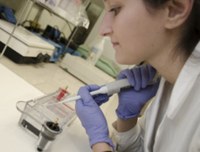
This was tested through a series of experiments on cultures of human tissues; if effective, this discovery could lead to new relevant strategies for reducing HIV contagion between men and women.
The extracellular nanoscopic vesicles released by some bacteria in the vaginal microbiota may be able to reduce contamination from HIV. This is what a joint study of the National Institutes of Health (USA) and the University of Bologna suggests. This study, recently published on Nature Communications, could pave the way for new strategies for preventing HIV from spreading in men/women intercourses.
Extracellular vesicles are spherical particles generated by many types of cells. They can perform a variety of functions in our bodies. However, it is generally assumed that they carry information from one cell to the other in the form of molecules. While carrying out this study, researchers isolated the extracellular vesicles of four strains of Lactobacillus. This bacterium plays a pivotal role in preventing the virus from spreading and is naturally present in the vaginal microbiota.
The researchers, in the lab, added some extracellular vesicles, produced by Lactobacillus, to a culture of human T-lymphocyte (a type of cells in our immune system). Later, they infected this culture with HIV. The researchers then compared this "enriched" culture with another one (without vesicles), and observed that HIV contagion was relevantly less frequent in the "enriched" culture. The higher the number of vesicles, the lower the number of HIV-infected cells. By the same token, by adding Lactobacillus vesicles to cultures of human tissues (notably of lymph nodes and cervix uteri), the number of HIV-infected cells decreased.
Thanks to these experiments, the researchers found out more about how to reduce contagion. Extracellular vesicles interfere with HIV ability to adhere to the cells surface and, consequently, with the virus ability to infect them. The vesicles act directly on the virus, by inhibiting some specific surface molecules, which HIV should employ in order to infect the cells.
“Extracellular vesicles from symbiotic vaginal lactobacilli inhibit HIV-1 infection of human tissues” is the title of this study published on Nature Communications. The leading author of the paper is Rogers Nahui Palomino, who is a post-doc fellow at the laboratory directed by Leonid Margolis at the NICHD – Eunice Kennedy Shriver National Institute of Child Health and Human Development, National Institutes of Health, USA. Rogers Nahui Palomino got his Ph.D. at the University of Bologna.
